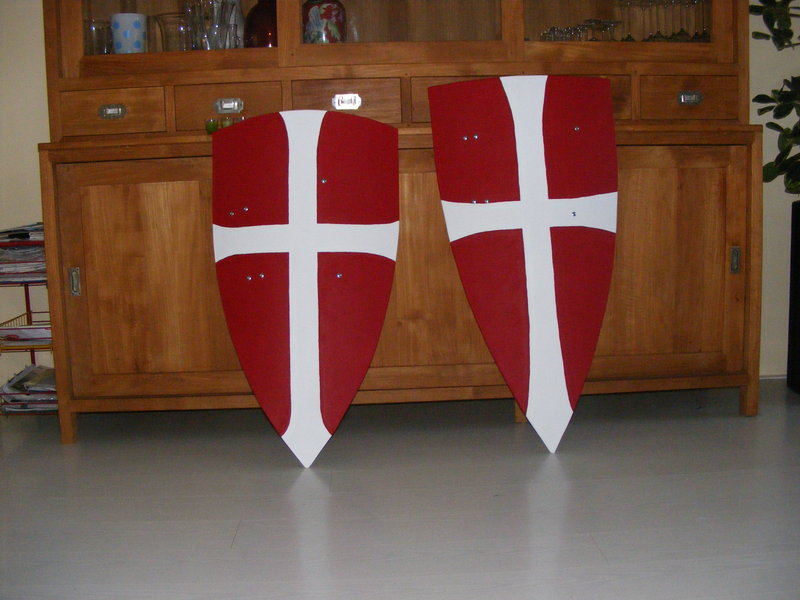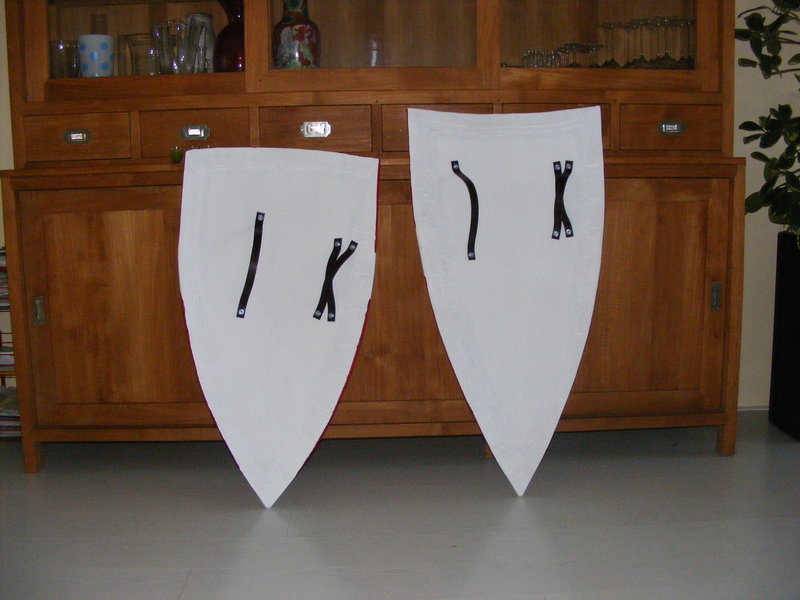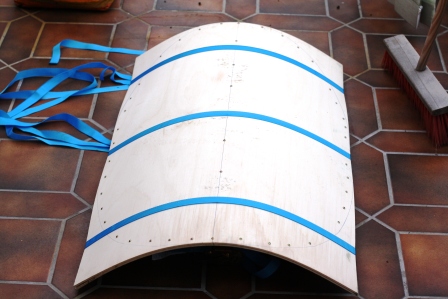Neat!
We have traditionally been using two layers of canvas (linen or cotton, doesn't really matter) and two strokes of standard acrylic paint from hoby stores. This has served us well for all practical purposes; Usually, the edges get chewed up long before the paint job is ruined.
As usually, you did a fine work there.
Thomas
Thomas
How about the quality differences in linen or cotton. Kohlmorgen writes in his book that one should prefere linne because cotton will get brittle over time.
I did use cotton anyways, because I had enough for my last shield.
But I bought 2 poplar sheets this week and will do an new shield and will have to buy the cloth for this one.
I did use cotton anyways, because I had enough for my last shield.
But I bought 2 poplar sheets this week and will do an new shield and will have to buy the cloth for this one.
| Felix R. wrote: |
| How about the quality differences in linen or cotton. Kohlmorgen writes in his book that one should prefere linne because cotton will get brittle over time.
I did use cotton anyways, because I had enough for my last shield. But I bought 2 poplar sheets this week and will do an new shield and will have to buy the cloth for this one. |
I would suspect that if you cover the cloth with modern paint (that gives adequate UV-protection), the difference in deteriation rate between linen and cotton fibre is negligable.
But depending on time and place, linen would likley be a much more available material than cotton.
Björn,
if one argues over cotton vs. linnen, he also should use tempera paints for historic accuracy, and not acrylic... Since most of us use acrylic, it doesn't really matter, which cloth is used...
Regards,
Thomas
if one argues over cotton vs. linnen, he also should use tempera paints for historic accuracy, and not acrylic... Since most of us use acrylic, it doesn't really matter, which cloth is used...
Regards,
Thomas
| Thomas R. wrote: |
| Björn,
if one argues over cotton vs. linnen, he also should use tempera paints for historic accuracy, and not acrylic... Since most of us use acrylic, it doesn't really matter, which cloth is used... Regards, Thomas |
Yes, if modern paint is used, what goes under the paint is less of an issue. It was more in reference to the described issue of cotton fibres becoming brittle over time..less of an issue with modern surface coating.
In regards the issue of springback, the best thing you can do is to over spring the shield to start with. There will always be a variable amount of springback that will vary from wood species to wood species. I DO NOT recommend steaming ordinary birch plywood that you buy at a hardware store, the glues will quite often release and then you have a real mess.
Using more layers of thinner plywood will also help. You should also investigate marine plywood. It is far sturdier, albeit heavier than birch, since it is generally mahogany or similar, and normally it can be steam bent without delaminating. Another item to try is DymondWood http://www.rutply.com/products/dymondwood.html not sure if you can get it there, but this stuff is HARD and pretty too. (Not very authentic however.)
Lee
Using more layers of thinner plywood will also help. You should also investigate marine plywood. It is far sturdier, albeit heavier than birch, since it is generally mahogany or similar, and normally it can be steam bent without delaminating. Another item to try is DymondWood http://www.rutply.com/products/dymondwood.html not sure if you can get it there, but this stuff is HARD and pretty too. (Not very authentic however.)
Lee
Thanks for the tips Lee. I'm still looking around for a new source of wood for my shields so this is helpful.
As for my shield, the temporary strapping is in place. As I said, no guige strap and it's attached with self-locking bolts instead of rivets just so it's finished in time for the Castlefest ren faire tonight. There will be several smiths there so I'll talk to them about making me some nice rivets. I also need to order more leather. The 2cm straps I ordered are not wide enough to do the fancy hole & lace method for adjustable straps. But all that will be taken care of after the fair.
Also, my shield has magically reproduced! :lol: The last few nights I have been working like mad to help a friend finish her shield in time for the ren faire as well. Aside from the overall shape it's exactly the same as mine.
 Attachment: 88.74 KB
Attachment: 88.74 KB

Shield front sides.
 Attachment: 86.21 KB
Attachment: 86.21 KB

Shield rear sides.
As for my shield, the temporary strapping is in place. As I said, no guige strap and it's attached with self-locking bolts instead of rivets just so it's finished in time for the Castlefest ren faire tonight. There will be several smiths there so I'll talk to them about making me some nice rivets. I also need to order more leather. The 2cm straps I ordered are not wide enough to do the fancy hole & lace method for adjustable straps. But all that will be taken care of after the fair.
Also, my shield has magically reproduced! :lol: The last few nights I have been working like mad to help a friend finish her shield in time for the ren faire as well. Aside from the overall shape it's exactly the same as mine.

Shield front sides.

Shield rear sides.
The Okume that you mentioned in one of your posts is one of the species of marine plywood that is available. Okume is harder than birch, comes in thickness's starting at 2mm, has more plies (which makes it stronger), but is generally heavier than birch, but you may be able to get away with a thinner shield to compensate.
| L. Clayton Parker wrote: |
| The Okume that you mentioned in one of your posts is one of the species of marine plywood that is available. Okume is harder than birch, comes in thickness's starting at 2mm, has more plies (which makes it stronger), but is generally heavier than birch, but you may be able to get away with a thinner shield to compensate. |
Strange. Perhaps there are several varieties then? The 4mm Okoume I got has the same number of plies as the 4mm birch (5 plies) and is much lighter, not heavier than the birch. In fact, it's so light that it feels flimsy. That's why I don't sell it to other people (though I haven't tested it for strength like I have the bitch shield. It may be stronger). The variant I have is called WBP I believe.
Still looking great.
However, why are the handgrips as flat/downwards? the way we use them, the shield edge should be level with your shoulders when standing in a relaxed guard with your arm up, next to your body.
However, why are the handgrips as flat/downwards? the way we use them, the shield edge should be level with your shoulders when standing in a relaxed guard with your arm up, next to your body.
| Elling Polden wrote: |
| However, why are the handgrips as flat/downwards? the way we use them, the shield edge should be level with your shoulders when standing in a relaxed guard with your arm up, next to your body. |
Good question. Tomas R. already asked the same via PM.
The shield in question is the one for my friend. This is the way she wanted it. The way I measure someone's strap is by asking them to hold their arm like they want to hold the shield, in a reasonably comfortable position. Then I hold the shield against their arm so that the top of the shield aligns with the shoulder. Then I mark it.
My friend's shield is mainly a costume piece, not meant for fighting (unlike mine). She said she'd be more comfortable carrying it around like this. But, I'll be sure to check with her after the fair when she's been carrying it like that for two days. Perhaps she'll change her mind.
| Sander Marechal wrote: | ||
Good question. Tomas R. already asked the same via PM. |
Seems to be, that Elling and I are what we would call in german "Alte Haudegen" ("old rapiers" / "veterans of war"), always concerned with practical aspects of swordsmanship and armor... :) :D :lol:
| Thomas R. wrote: | ||||
Seems to be, that Elling and I are what we would call in german "Alte Haudegen" ("old rapiers" / "veterans of war"), always concerned with practical aspects of swordsmanship and armor... :) :D :lol: |
additionally, a slight upward angle would help stabilizing the shield when held, while holding it with horizontal grip might result in collapse under pressure.
Hi all. I just came back from the Castlefest fair where the shields suffered from two days of bad weather and general (ab)use. Overall they held up very well but there is a small problem with the paint coat. At the edges and corners that got really wet (from standing in the wet grass) some of the paint has come off. I suspect that the spray-can varnish that I used didn't cover the edges all too well.
I would like to give them one additional coat of paint and then use a can of varnish (the kind you put on with a brush) to seal it. That's what one of the other people in out group did and his shield suffered much less from this problem. But how would I do this, since the shields are mostly covered by the spray-on varnish? The exact varnish that I used is 115 from Royal Talens, a matt varnish based on turpentine that's suitable for both arcylic paint and oil paint.
Can I simply lightly sand the shields and paint over the varnish with acrylic paint? Or do I need to remove the entire varnish layer first (e.g. with mineral turpentine)?
Thanks in advance!
I would like to give them one additional coat of paint and then use a can of varnish (the kind you put on with a brush) to seal it. That's what one of the other people in out group did and his shield suffered much less from this problem. But how would I do this, since the shields are mostly covered by the spray-on varnish? The exact varnish that I used is 115 from Royal Talens, a matt varnish based on turpentine that's suitable for both arcylic paint and oil paint.
Can I simply lightly sand the shields and paint over the varnish with acrylic paint? Or do I need to remove the entire varnish layer first (e.g. with mineral turpentine)?
Thanks in advance!
Not to spoil this thread, just an addition to show an alternative.
Of course the press is more accurate, as long as it is made well.
This is quite easy to curve the wood just using spanning straps. More straps or wooden slats along the sides will make the edge more even. But after cutting of the excess wood, you don´t see much of it. Screws help to avoid gaps while the glue sets. You can avoid any torque by putting some weights along the centre line pressing the shield to the even ground.
 Attachment: 89.59 KB
Attachment: 89.59 KB

Of course the press is more accurate, as long as it is made well.
This is quite easy to curve the wood just using spanning straps. More straps or wooden slats along the sides will make the edge more even. But after cutting of the excess wood, you don´t see much of it. Screws help to avoid gaps while the glue sets. You can avoid any torque by putting some weights along the centre line pressing the shield to the even ground.

I shaped plywood for a 100x60cm (40*24") kite shield by pressing it into a bathtub until it was bent to desired curvature. It worked quite well, plywood got nice even curve along whole length, even better than I expected.
Hey, I really like Felix's "not over-thinking it" approach. I've been wanting to make a shield but daunted by the thought of having to make the press first.
No doubt, a press like Gaffer's is the Pro way to go, especially if you're doing them for a group or organization. However, for my first foray I think I'll try the straps with wood along the edges as suggested (like 3/4 round or some kind of corner moulding.)
(Honorable Mention to Walter for the most economical "strapless" approach!)
No doubt, a press like Gaffer's is the Pro way to go, especially if you're doing them for a group or organization. However, for my first foray I think I'll try the straps with wood along the edges as suggested (like 3/4 round or some kind of corner moulding.)
(Honorable Mention to Walter for the most economical "strapless" approach!)
In 2 days, my shield changed shape from properly curved to flat, slightly warped - I guess I must have done something incorrectly :(
How did you go about it Walter? Plywood shields hold their curve by gluing multiple layers together, bending them and then let the glue dry. When the glue sets, the curve will remain.
Page 4 of 5
You cannot post new topics in this forumYou cannot reply to topics in this forum
You cannot edit your posts in this forum
You cannot delete your posts in this forum
You cannot vote in polls in this forum
You cannot attach files in this forum
You can download files in this forum
All contents © Copyright 2003-2006 myArmoury.com — All rights reserved
Discussion forums powered by phpBB © The phpBB Group
Switch to the Full-featured Version of the forum
Discussion forums powered by phpBB © The phpBB Group
Switch to the Full-featured Version of the forum